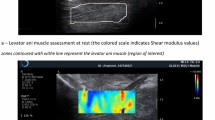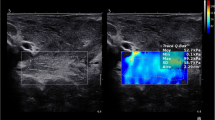Abstract
This study aimed to quantitatively assess the quality of levator ani muscle (LAM) using shear wave elastography (SWE) and to evaluate the association between the elasticity of LAM and stress urinary incontinence (SUI). The study population included 32 women with SUI and 34 women with normal pelvic support. The thickness of LAM, bladder neck descent (BND), and urethral funneling (UF) were assessed by transperineal ultrasound. LAM elasticity was measured by SWE at rest and during the maximal Valsalva maneuver. Age, menopause, BND, and UF showed a positive correlation with SUI. There was no significant between-group difference in the elastic modulus values of LAM at rest. The thickness of LAM in women with SUI was greater than that in control group at rest and during the maximal Valsalva maneuver (P < 0.001). The elastic modulus values of Emax and Emean were significantly increased from rest to the maximal Valsalva maneuver in all participants (56.24 vs 82.43 kPa and 47.92 vs 72.37 kPa, P < 0.001). The change of these variables from rest to the maximal Valsalva maneuver in the control group was more obvious than that in the SUI group (34.09 vs 17.87 kPa and 31.55 vs 16.82 kPa, P < 0.05). The elasticity of LAM, as quantified by SWE, may potentially be used as an index for predicting SUI.





Similar content being viewed by others
References
Rubilotta E, Balzarro M, D'Amico A, Cerruto MA, Bassi S, Bovo C, Iacovelli V, Bianchi D, Artibani W, Finazzi Agro E: Pure stress urinary incontinence: analysis of prevalence, estimation of costs, and financial impact. BMC Urol 2019, 19(1):44.
Hunskaar S, Burgio K, Diokno A, Herzog AR, Hjalmas K, Lapitan MC: Epidemiology and natural history of urinary incontinence in women. Urology 2003, 62(4 Suppl 1):16-23.
Milsom I, Gyhagen M: The prevalence of urinary incontinence. Climacteric 2019, 22(3):217-222.
Lukacz ES, Santiago-Lastra Y, Albo ME, Brubaker L: Urinary Incontinence in Women: A Review. JAMA 2017, 318(16):1592-1604.
van Veelen A, Schweitzer K, van der Vaart H: Ultrasound assessment of urethral support in women with stress urinary incontinence during and after first pregnancy. Obstet Gynecol 2014, 124(2 Pt 1):249-256.
DeLancey JO: The anatomy of the pelvic floor. Curr Opin Obstet Gynecol 1994, 6(4):313-316.
Dietz HP, Simpson JM: Levator trauma is associated with pelvic organ prolapse. Bjog 2008, 115(8):979-984.
Andrew BP, Shek KL, Chantarasorn V, Dietz HP: Enlargement of the levator hiatus in female pelvic organ prolapse: cause or effect? The Australian & New Zealand journal of obstetrics & gynaecology 2013, 53(1):74-78.
Dietz HP, Franco AV, Shek KL, Kirby A: Avulsion injury and levator hiatal ballooning: two independent risk factors for prolapse? An observational study. Acta obstetricia et gynecologica Scandinavica 2012, 91(2):211-214.
Barber MD: Contemporary views on female pelvic anatomy. Cleve Clin J Med 2005, 72 Suppl 4:S3-11.
Ma MK, Law HK, Tse KS, Chan KW, Chan GC, Yap DY, Mok MM, Kwan LP, Tang SC, Choy BY et al: Non-invasive assessment of kidney allograft fibrosis with shear wave elastography: A radiological-pathological correlation analysis. International journal of urology : official journal of the Japanese Urological Association 2018, 25(5):450-455.
Gennisson JL, Deffieux T, Fink M, Tanter M: Ultrasound elastography: principles and techniques. Diagnostic and interventional imaging 2013, 94(5):487-495.
Xie M, Zhang X, Liu J, Ding J, Ren Y, Hua K: Evaluation of levator ani with no defect on elastography in women with POP. International journal of clinical and experimental medicine 2015, 8(6):10204-10212.
Xie M, Zhang X, Zhang X, Wang W, Hua K: Can we evaluate the levator ani after Kegel exercise in women with pelvic organ prolapse by transperineal elastography? A preliminary study. Journal of medical ultrasonics (2001) 2018, 45(3):437–441.
Gachon B, Nordez A, Pierre F, Fradet L, Fritel X, Desseauve D: In vivo assessment of the levator ani muscles using shear wave elastography: a feasibility study in women. International urogynecology journal 2019, 30(7):1179-1186.
Al Adem KM, Bawazir SS, Hassen WA, Khandoker AH, Khalaf K, McGloughlin T, Stefanini C: Implantable Systems for Stress Urinary Incontinence. Ann Biomed Eng 2017, 45(12):2717-2732.
Committee Opinion No. 603: Evaluation of uncomplicated stress urinary incontinence in women before surgical treatment. Obstet Gynecol 2014, 123(6):1403-1407.
Fry CH, Meng E, Young JS: The physiological function of lower urinary tract smooth muscle. Auton Neurosci 2010, 154(1-2):3-13.
Beard JR, Officer A, de Carvalho IA, Sadana R, Pot AM, Michel JP, Lloyd-Sherlock P, Epping-Jordan JE, Peeters G, Mahanani WR et al: The World report on ageing and health: a policy framework for healthy ageing. Lancet 2016, 387(10033):2145-2154.
Mathew S, Guzmán Rojas RA, Salvesen KA, Volløyhaug I: Levator ani muscle injury and risk for urinary and fecal incontinence in parous women from a normal population, a cross-sectional study. Neurourology and urodynamics 2019, 38(8):2296-2302.
Enhorning G: Simultaneous recording of intravesical and intra-urethral pressure. A study on urethral closure in normal and stress incontinent women. Acta chirurgica Scandinavica Supplementum 1961, Suppl 276:1–68.
Naranjo-Ortiz C, Shek KL, Martin AJ, Dietz HP: What is normal bladder neck anatomy? International urogynecology journal 2016, 27(6):945-950.
Sadeghi S, Johnson M, Bader DA, Cortes DH: The shear modulus of lower-leg muscles correlates to intramuscular pressure. Journal of biomechanics 2019, 83:190-196.
Corrigan P, Zellers JA, Balascio P, Silbernagel KG, Cortes DH: Quantification of Mechanical Properties in Healthy Achilles Tendon Using Continuous Shear Wave Elastography: A Reliability and Validation Study. Ultrasound in medicine & biology 2019, 45(7):1574-1585.
Taljanovic MS, Gimber LH, Becker GW, Latt LD, Klauser AS, Melville DM, Gao L, Witte RS: Shear-Wave Elastography: Basic Physics and Musculoskeletal Applications. Radiographics 2017, 37(3):855-870.
Wang J, Wu M, Linghu R, Chang J, Wu M, Feng C, Ren X, Liu C, Lin J, Song T et al: Usefulness of New Shear Wave Elastography Technique for Noninvasive Assessment of Liver Fibrosis in Patients with Chronic Hepatitis B: A Prospective Multicenter Study. Ultraschall in der Medizin (Stuttgart, Germany : 1980) 2021.
Hug F, Tucker K, Gennisson JL, Tanter M, Nordez A: Elastography for Muscle Biomechanics: Toward the Estimation of Individual Muscle Force. Exerc Sport Sci Rev 2015, 43(3):125-133.
Dobruch-Sobczak K, Guminska A, Bakula-Zalewska E, Mlosek K, Slapa RZ, Wareluk P, Krauze A, Ziemiecka A, Migda B, Jakubowski W et al: Shear wave elastography in medullary thyroid carcinoma diagnostics. J Ultrason 2015, 15(63):358-367.
Tang JH, Zhong C, Wen W, Wu R, Liu Y, Du LF: Quantifying Levator Ani Muscle Elasticity Under Normal and Prolapse Conditions by Shear Wave Elastography: A Preliminary Study. J Ultrasound Med 2020, 39(7):1379-1388.
Tunn R, Goldammer K, Neymeyer J, Gauruder-Burmester A, Hamm B, Beyersdorff D: MRI morphology of the levator ani muscle, endopelvic fascia, and urethra in women with stress urinary incontinence. European journal of obstetrics, gynecology, and reproductive biology 2006, 126(2):239-245.
Mandl T, Meyerspeer M, Reichel M, Kern H, Hofer C, Mayr W, Moser E: Functional electrical stimulation of long-term denervated, degenerated human skeletal muscle: estimating activation using T2-parameter magnetic resonance imaging methods. Artif Organs 2008, 32(8):604-608.
Eby SF, Cloud BA, Brandenburg JE, Giambini H, Song P, Chen S, LeBrasseur NK, An KN: Shear wave elastography of passive skeletal muscle stiffness: influences of sex and age throughout adulthood. Clin Biomech (Bristol, Avon) 2015, 30(1):22-27.
Author information
Authors and Affiliations
Corresponding author
Ethics declarations
Conflict of interest
The authors declare no conflict of interest.
Additional information
Publisher's Note
Springer Nature remains neutral with regard to jurisdictional claims in published maps and institutional affiliations.
Rights and permissions
About this article
Cite this article
Li, X.M., Zhang, L.M., Li, Y. et al. Usefulness of transperineal shear wave elastography of levator ani muscle in women with stress urinary incontinence. Abdom Radiol 47, 1873–1880 (2022). https://doi.org/10.1007/s00261-022-03478-5
Received:
Revised:
Accepted:
Published:
Issue Date:
DOI: https://doi.org/10.1007/s00261-022-03478-5




